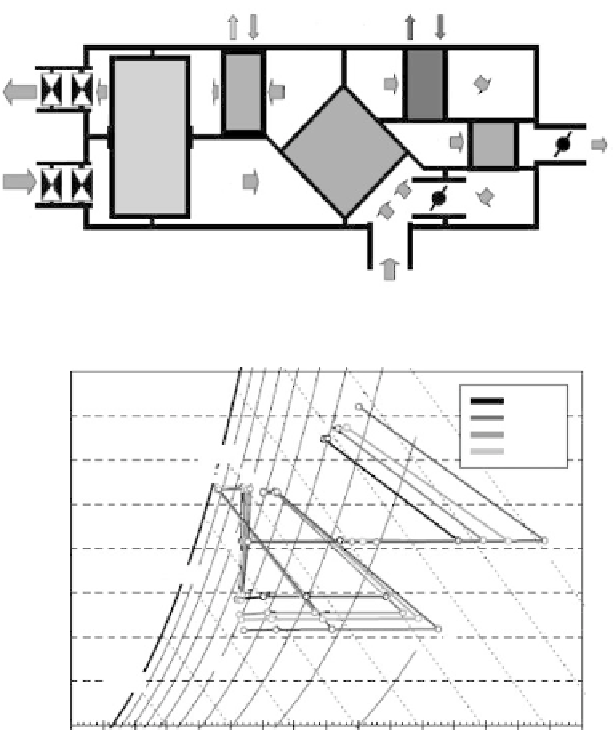Environmental Engineering Reference
In-Depth Information
(a)
WARM
WATER
HOT
WATER
WATER
OUT
WATER
IN
A
H
C
D
E
C
4'
5'
12
F N F N
10
9
11
EXIT
AIR
HEAT
EXCHANGER
[HEX-1]
4
HEX[2]
5
SUPPLY
AIR
1
F N F N
3
2
8
6
OUTDOOR
AIR
RETURN
AIR
7
(b)
0.022
11 12
11 12
11 12
11 12
60
°
C RT
0.020
65
°
C RT
70
°
C RT
70 kJ/kg
75
°
C RT
0.018
6
5
12
0.016
99 9 9
8
0.014
10 10
10
10
50 kJ/kg
4
0.012
4
4
3
5
5
3
4
3
5
4
4
4
3
0.010
4
50
0.008
30 kJ/kg
0.006
0
5 0 5 0 5 0 5
Dry Bulb Temperature (
40
45
50
55
60
65
70
75
80
C)
Figure 16.3.2
Constant humidity ratio supply air solid desiccant air-conditioning system: a) system
diagram; b) psychrometric chart (Enteria et al., 2010b; Enteria et al., 2010c).
it has lower regeneration temperature requirements with higher COP. Kodama et al.
(2005) show the multi-pass desiccant wheel presented in Figure 16.3.4. This shows
that a 50
◦
C regeneration temperature is enough for the desiccant wheel. Furthermore,
Kodama et al. (2003) presented several designs of the desiccant air-conditioning system
for humid climates, conditions in which the 4-wheel cycle (two desiccant wheels and
two heat wheels) can be used. However, the 3-wheel cycle (1 desiccant wheel, 1 heat
wheel and 1 total heat exchanger) proved better than the 4-wheel cycle.
The fixed-bed solid desiccant air-conditioning system is another type of modified
system, on which several design studies have been conducted. The advantage of the
fixed-bed system is the sorption process, which can be done in an isothermal way.

Search WWH ::

Custom Search